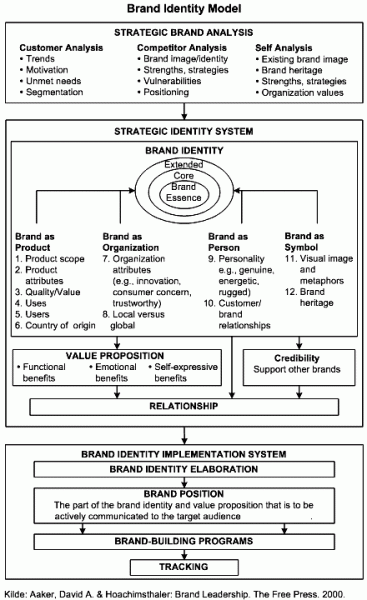Aaker’s Brand Vision Model
When David Aaker developed the Brand Vision Model in 1996 (originally called the Brand Identity Model), it was partially an act of rebellion.
In a 2018 episode of How Brands are Built, Aaker stressed his dislike of the ‘fill-in-the-box’ approach to brand development that was the status quo at the time.
“I’ve been an advisor for one of the major global agencies and they had this fill in the box model, it just drove me crazy. They would have eight boxes and you had to fill each one. Of course, it was really designed around B2C things, that was most of their clients, and if you were a B2B business, there was no box for organizational values. You didn’t have it and yet there was a box of brand personality. So even though that wasn’t relevant to your brand, it had no place in the brand vision, you had to fill in the box, it was a borderline tragedy.”
And so the Brand Vision Model was born to offer a flexible structure to guide strategists and marketers through brand development.
“When the brand vision clicks, it will reflect and support the business strategy, differentiate from competitors, resonate with customers, energize and inspire employees and partners, and precipitate a gush of ideas for marketing programs. When absent or superficial, the brand will drift aimlessly and marketing programs are likely to be inconsistent and ineffective.” – David Aaker
HOW IT WORKS

Step 1 – Background research
Aaker suggests a procedural approach, starting with analysis and research on customers, competitive landscape and current brand / organisational priorities. The inclusion of this critical step in the visualisation of the Model is relatively unique, where other models might make the assumption that brand development is backed by qualitative and quantitative research.
Step 2 – Explore brand identity
The core of the Brand Vision Model is in the centre box – “Strategic Identity System”. This is comprised of the Brand Essence, Core Elements and Extended Elements. There are no requirements or hard rules on what these three elements need to include. In fact, there is no requirement that they be included at all, particularly the Brand Essence.
(In this context, the Brand Essence refers to a succinct summary of the brand identity that encapsulates the theme of the brand vision. This is usually an internal phrase, not a tagline, although there are exceptions. Aaker’s example is Panasonic’s “Ideas for Life”.)
Instead, Aaker suggests brainstorming a list of attributes that reflect what the “brand should stand for in customer’s minds.” Aaker also stresses that there is no minimum or maximum number of elements that can be included, and that this exercise should take an aspirational approach. Brand elements do not need to be true to the brand today, but rather a vision of the future.
As shown in the illustration, attributes should consider brand through a number of lenses including:
- Brand as product
- Brand as organisation
- Brand as person
- Brand as symbol
Some of these elements will be more relevant than others for each brands. For example, B2B services might be less concerned with the human characteristics of “brand as a person” but more interested in their own internal culture and processes (“brand as an organisation”).
Step 3 – Prioritise and refine
After compiling an extensive list of brand elements, classify each as Core or Extended. Aaker notes that this process “lays a really useful role because they provide extra texture and guidance for something that’s not front and centre.” He also has observed the tendency for brand builders to feel limited in their development process when the brand vision is narrow in scope. Instead, a broader view provides guardrails while giving permission to stretch.
Step 4 – Implement
With a refreshed view of the brand, evaluate messaging and creative executions on whether they further the brand goals. Use the Brand Vision Model documentation to brief partners, creatives and marketing teams on future strategy.
Step 5 – Measure and track
The Brand Vision Model also includes tracking at the end of its process. Traditional brand tracking, media engagement and sales are all useful inputs in determining whether the new strategy resonates with customers, differentiates the brand and is achievable.
FINAL THOUGHTS
The Brand Vision Model offers a reminder that brand building does not need to be a rigid practice that needs to fit into a box. Instead, it should be a process of discovery, aspiration and dare we say – joy.
FURTHER READING / SOURCES
https://www.prophet.com/2014/03/185-it-starts-with-a-brand-vision/




